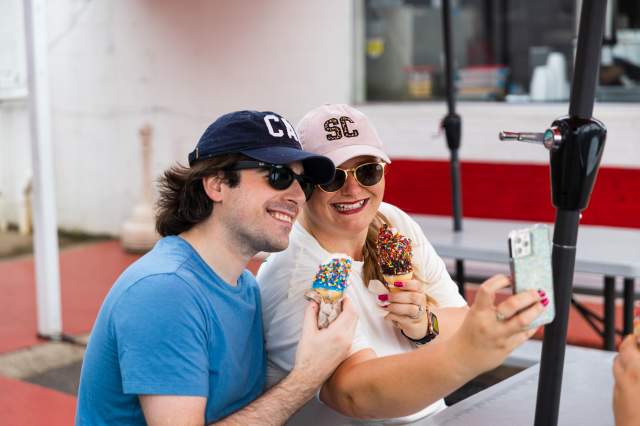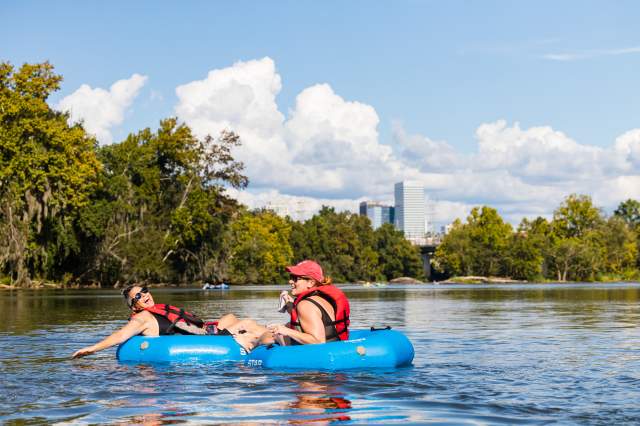In honor of Black History Month, join us as we explore the myriad of significant African-American sites that make up the rich history of Columbia SC.
Cultural Attractions
On Hampton Street in the heart of downtown Columbia, you will stumble upon a beautiful white building with a bright red door. Built originally as the House of Peace Synagogue in the early 1900s and later sold + relocated in 1936, this historic building became a prevalent African-American nightclub called “The Big Apple.” Stroll along the 1500 block of the recently revitalized Main Street where you will notice the Kress Building—a 1935 structure that housed a “Whites Only” lunch counter. The Kress Building is one of the eight locations in Columbia where students protested and held sit-ins during the 1960s Civil Rights Movement.
From the Kress Building, head North on Main Street toward the South Carolina State House and walk the grounds where several Civil Rights demonstrations and rallies were held in the 1960s. To the left of the State House lies the African-American History Monument, which was designed (by Sculptor Ed Dwight) as tribute to the rich history of African Americans and their contributions to South Carolina. The monument is modeled after an African village built in the round and includes a map of the continent mounted in granite, showing the original homelands of the enslaved Africans. The monument's panels pick up the story from their arrival in the port city of Charleston into the 21st century. We recommend going to see it at night when it’s lit up.
If you find yourself in Five Points, make the short drive down Harden Street toward Benedict College where you will find the Carver Theatre—the only still-standing theater that was built exclusively for the African-American community of Columbia. The theater served as an entertainment hub for African Americans when public structures in Columbia were still segregated.
Finally, make a point to visit Thomas Cooper Library at the University of South Carolina to admire the recently unveiled statue of Richard T. Greener—the university’s first black professor, Harvard’s first black graduate and the country’s first black diplomat to a country of white citizenry.
Historic Districts
Bordered by Harden, Gervais and Taylor Streets and Millwood Avenue lies the Waverly Historic District—one of the most prominent black communities in Columbia since the 1930s. The origin of the Waverly community began with Robert Latta’s purchase of a 60-acre plot in 1855, where his widow and children later sold the first lots to black citizens in the early 1860s. Further developed following the Civil War, Waverly continued to expand for the next 50 years and was annexed by the City of Columbia in 1913. Drawing students from Benedict College and Allen University, the community was almost entirely black by 1930.
Benedict College—named in honor of Rhode Island abolitionist Stephen Benedict—was originally established as “Benedict Institute,” a training facility for black Baptist ministers and teachers, and later renamed Benedict College in 1984. The campus had its first black president in 1929 and was the home of an NAACP branch that initiated in 1937. Today the campus is home to numerous historic buildings, including Morgan Hall, Antisdel Chapel and Starks Center. Moved to Columbia from Cokesbury in 1880, Allen University (originally “Payne Institute”) was named after the founder of the African Methodist Episcopal Church, Bishop Richard Allen.
On Richland Street in downtown Columbia, take a self-guided walking tour through the Arsenal Hill District, named for the military academy established in Columbia in 1842. As the highest point within the city’s downtown, Arsenal Hill became a residential area for middle and working-class African Americans during the 19th and 20th centuries
Historic Homes
While visiting the Arsenal Hill District, stop by the Mann-Simons Site on Richland Street. Operated today as a house museum by Historic Columbia, the Mann-Simons Site is assumed to have been built between 1825 and 1830. The cottage is earliest associated with Celia Mann—an African-American woman who was born in Charleston into slavery in 1799. Passed down from Celia to her daughters and then to later generations, the museum takes visitors through the history of this African American family’s experiences and challenges through a period of nearly 130 years.
Don’t forget to visit the Modjeska Monteith Simkins House. Born in Columbia and graduate of Benedict College, Simkins was a warrior for African-American public health + social reform, prominent leader of the Civil Rights Movement in South Carolina, and founder of the South Carolina Conference of the NAACP. Today, what was her second home in Columbia SC is also operated as a museum by Historic Columbia.
The Harriet Barber House in Lower Richland was built in 1880. In the late 1880s, the South Carolina Land Commission attempted to give freed African Americans the opportunity to own property. Thus, Samuel and Harriet Barber purchased 42.5 acres of land from the commission. While it wasn’t uncommon for the freedmen to later lose their land, the Harriet Barber House continues to be owned by the Barber family.
Also in Lower Richland, visit the Magnolia Slave House at Wavering Place Plantation—a Greek Revival mansion that was originally built for Frances Tucker Hopkins, the wealthy widow of prominent cotton planter David Thomas Hopkins. The slave house is roughly 150 feet from the mansion and was the home to many house servants.
Historic Markers
Moved to Sumter Street in 1921, Bethel AME Church of Columbia was originated for the black community in 1866, following the Civil War. Designed by John Anderson Lankford, one of the first registered black architects in the US, the beautiful Romanesque Revival-style building is a must see when visiting Columbia.
Another can’t-miss historic marker in Columbia is Zion Baptist Church on Gadsden street. Moved to this site in 1871 and rebuilt in 1916, Zion Baptist is where Dr. Matilda Evans opened her free clinic. Dr. Evans was the first African-American woman in South Carolina to have her own medical practice. Most notably, Zion Baptist is where 200 African-American students met before their anti-segregation march on the state house in 1961.
Toward the West end of Elmwood Avenue lies the Randolph Cemetery—an 1870s cemetery established by a group of African-American civic leaders. Expanded in 1899, the cemetery was named for Benjamin Franklin Randolph, an African American who was killed by white men when he was campaigning for the Republican party in Abbeville County in 1868. The cemetery is home to a monument in Randolph’s honor and the burial site of eight African-American members of the General Assembly, as well as other leaders of the African-American community of Columbia.
A recent addition to the area’s African-American history, Brookland Baptist Church was one of the stops during President Obama’s visit to South Carolina in 2015. He stopped into during lunch at the church’s “Brookland Café” with Columbia locals + visitors alike. Stop in for lunch the next time you’re in town.
Events
Visit the Smithsonian Traveling Exhibit: Crossroads: Change in Rural America at the Harriet Barber House. Feb. 9 - March 24. An opening reception featuring renowned artist Jonathan Green will be held at Hopkins Middle School from noon to 1:30 p.m. on Feb. 9.
Historic Columbia will offer tours and lectures on African American Sites during the month of February.
- The Second Sunday Roll will feature African American Historic Sites on Sunday, Feb. 10, from 2 - 3:30 p.m. From the Mann-Simons Site, to the North Carolina Mutual Building, this tour explores houses, businesses and other important African American sites.
- A Research Roundtable will be held Tuesday. Feb. 26 from 12 – 1 p.m. at the Seibels House, honoring Modjeska Monteith Simkins. Simkins was born in Columbia, S.C. on December 5, 1899 and over the course of her 92 years, she displayed a courage and perseverance that many argue was unmatched. Join Katharine Allen, research and archives manager at Historic Columbia, for a presentation on how HC plans to honor her life and legacy.
The Benedict College Harambee Festival will celebrate its 30th anniversary on Saturday, Feb. 23 from 9:30 a.m. to 5:30 p.m. Grammy Award-winning gospel singer Donal Lawrence will host an album listening party for the forthcoming “Goshen” album at 8 p.m. in the David H. Swinton Campus Center.
Richland County Library will offer a full roster of programs celebrating Black History Month that are free and open to the public. The events range from author events to musical and spoken word performances to movie screenings, food tastings, lectures, arts and crafts and exhibits. For a full list visit richlandlibrary.com.
The City of Columbia Parks and Recreation Department will have its Black History Heritage Ball on Feb. 24 from 5 to 8 p.m. at Greenview Park. The event will feature dinner and live entertainment.
For more interesting facts and a comprehensive list of black history sites in Columbia SC, check out the Green Book of South Carolina.
Source: The Green Book of South Carolina, SC Archives & History.


